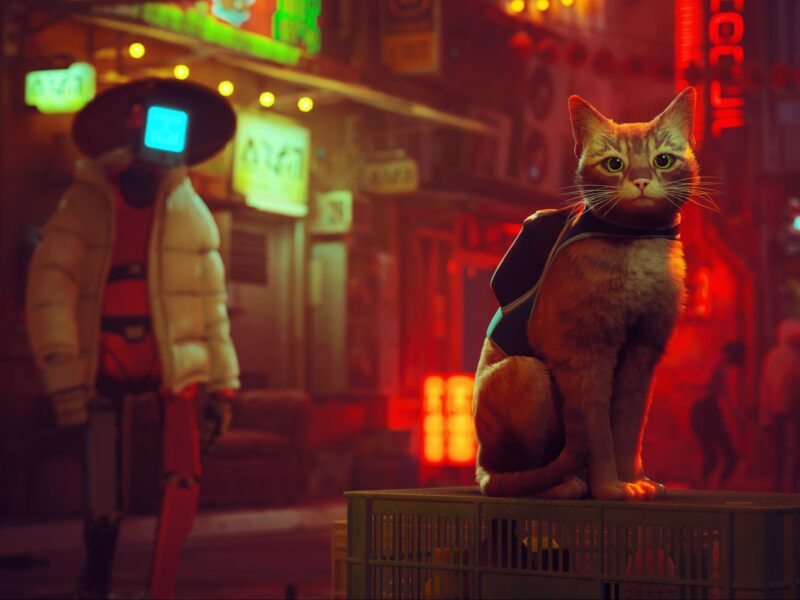Getting ready to release Teenage Mutant Ninja Turtles: Shredder Revenge!
Beatem up called Teenage Mutant Ninja Turtles: Shredder Revenge is one of the biggest announcements of 2021. Teenage Mutant Ninja Turtles are truly iconic characters for millennials, and for some zoomers too.
But they became a symbol of the 1990s, including thanks to video games! But then something went wrong – the last decent game about turtles came out 14 years ago, so there are high hopes for Shredder Revenge. In the meantime, we are waiting for it, you can go through the classics – there were a lot of bad games on the “Turtles”, but there will be enough good ones.
Teenage Mutant Ninja Turtles II: The Arcade Game (1990)
The game was originally released on slot machines in 1989 under the name Teenage Mutant Ninja Turtles. But when it came to its NES port, I had to dodge – “Turtles” with that name already came out on consoles in 1989 (they were so-so). Yes, the history of Teenage Mutant Ninja Turtles is a little shorter than the history of the entire franchise, created in 1984. The well-known company Konami in the late 1980s received the rights to develop and release games based on the Teenage Mutant Ninja Turtles and put them on stream.
The Arcade Game, like almost all early turtle games, draws on the “same” 1987 animated series – even its opening sequence repeats frames from the TV show opening. It all starts with the fact that Shredder, with the help of Rocksteady, kidnaps journalist April ONeil, and the turtles set off in pursuit of them. They manage to rescue April at the very beginning of the game, and then the heroes make their way to the Technodrome, the base of Shredder and Krang. The technodrome will eventually be destroyed, but the fate of the villains will remain unknown.
The Arcade Game is a beatem up in the style of Double Dragon II, but with simplified gameplay. You can play for any of the four turtles, however, there is no significant difference between them. The combat system is based on a “normal” weapon attack, an enhanced attack and a jump kick – a diagonal dive kick, like Kung Lao in Mortal Kombat 3. There are no grabs and throws on the NES, but you can repel some long-range attacks. Surprisingly, such an ascetic set is enough for the game.
Its worth trying both the arcade version and the console version. The first one has an order of magnitude better picture and sound, there are throws and it can be played by four people. The second is designed for a maximum of two players, but it has two additional levels.
Teenage Mutant Ninja Turtles III: The Manhattan Project (1991)
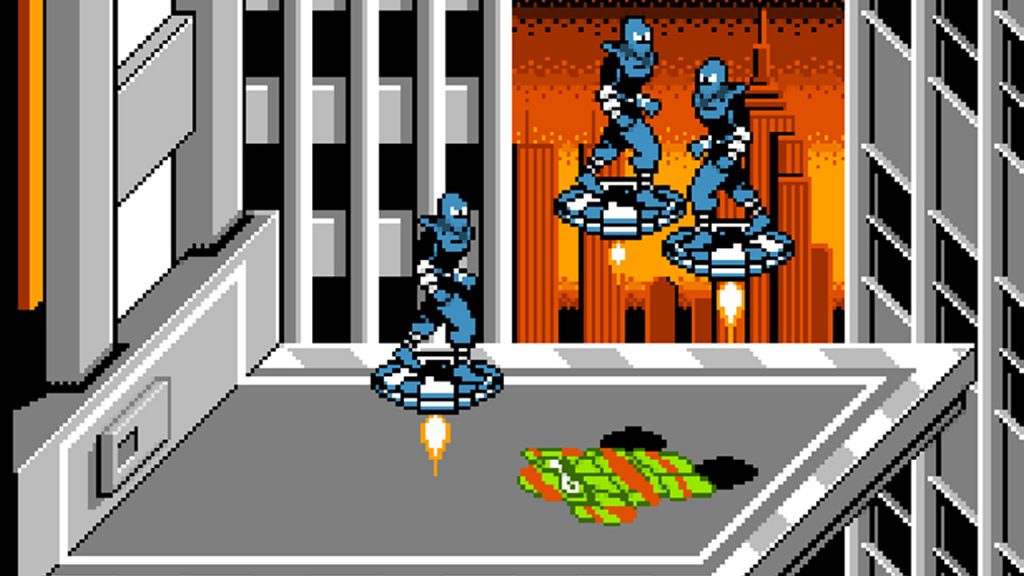
The third part of “Turtles” for the NES was especially popular in the territory of the former USSR, although it never officially came out in Europe. The Manhattan Project was developed immediately for the NES, and therefore squeezed the juice out of the console as it should – partly because of this, it was a must-have purchase for every Dandy owner.
Stylistically, the game again drew on the 1987 series. According to the plot, the turtles are vacationing in Florida and watching Aprils report from Manhattan. But then Shredder suddenly appears on the screen – he takes the journalist hostage, and literally rips the whole of Manhattan out of the ground, turning part of New York into a flying island.This time the main characters save Eypril in the middle of the game, after a fight with a shredder. However, the villain escapes, and the Crang Spacecraft appears above Manhattan. In the finals, the shredder, scolding a mutagen, turns into a super shutter. But the turtles won all again and return Manhattan to the place.
Gameplayo The Manhattan Project is improved almost in all the parameters of The Arcade Game. Levels here are more diverse, opponents are more, the bass patterns are more interesting. Even enemies jump out of the most unexpected places and arrange traps – for example, a billboard can drop on the turtles. Only with a combat system was strange. She exactly became richer: the strengthened blow now takes away the health and the turtle itself, and throwing a throw through itself to ordinary shocks. But the throw is so powerful that it is almost meaningless to apply other attacks. Because of this, playing Leonardo and Donatello slightly easier than behind the other turtles.
Teenage Mutant Ninja Turtles IV: Turtles In Time (1991)
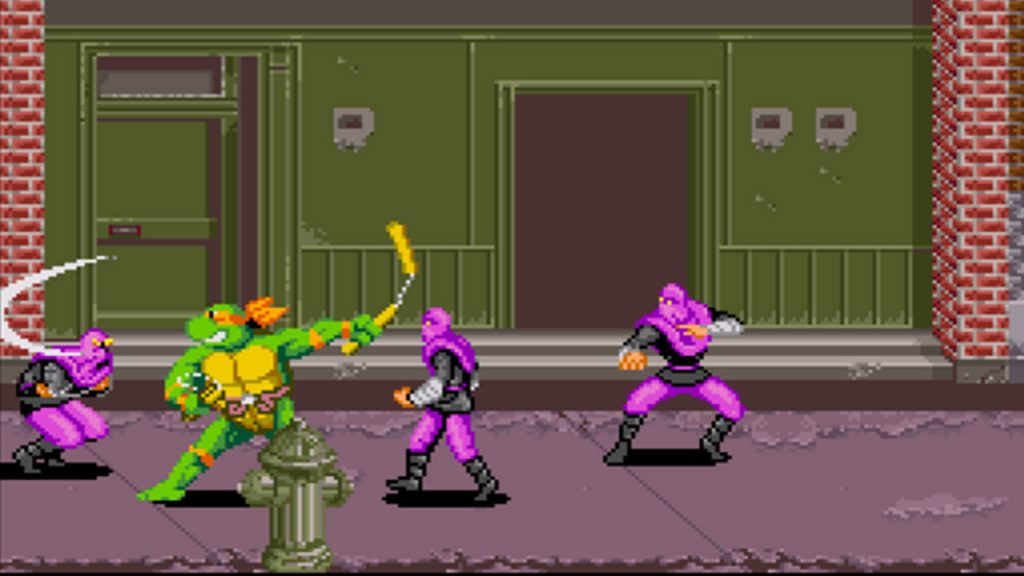
Like the previous one, Turtles In Time initially came out on arcade machines without a figure in the title – the fourth acquired a better known version for SNES. On the territory of the former USSR, she is not as good as games with “Dandy”, but in the world it is considered the absolute classic of “turtles” and in the lists of the best retro projects Beat EM UP comes regularly.
The game is based not only on the animated series, but also on the film “Ninja Turtle II: the Mystery of Emerald Potion” 1991. However, this concerns only stylistics and characters – the plot in Turtles in Time. Turtles As usual, Aypril reportage – the girl broadcasts from the statue of freedom. Suddenly, Crang appears in a huge bargaining and stealing a statue, after which a laughing shredder bursts on the air. Turtles are in a hurry to hide the villains and quickly get to the tehnodrome, but there they meet the shredder and throws the heroes to a temporary funnel. Bugs have to go through different epochs – from the Stone Age to a distant future. At the end, they are waiting for the fight with the super-holder and the return of the statue of freedom in place.
Gameplay in Turtles In Time is typical for its time, but very good and tactful pleasant. This is generally the main thing in such games – so that the fingers are cool when the characters on the screen mutilated each other. Ordinary attacks are now clearly folded into combo. You can be drunk behind the back of the opponents (however, leaving a defenseless person), run, beat from running out, and even grab the enemy and prey to enjoy him about the Earth or throw away. The difference between the turtles is now felt much stronger – at least at the speed of attack. And also from different turtles unique reinforced blows.
As in the case of The Arcade Game, the console version and arcade are trying to try. The differences between them are not only in the chart, sound and number of players, but also in content. Snees appeared on the SNES, new enemies and bosses were added, and some old were replaced. The final battle is also different – in the arcade version, everything ends with the battle with the usual shredder.
Teenage Mutant Ninja Turtles: Manhattan Missions (1991)
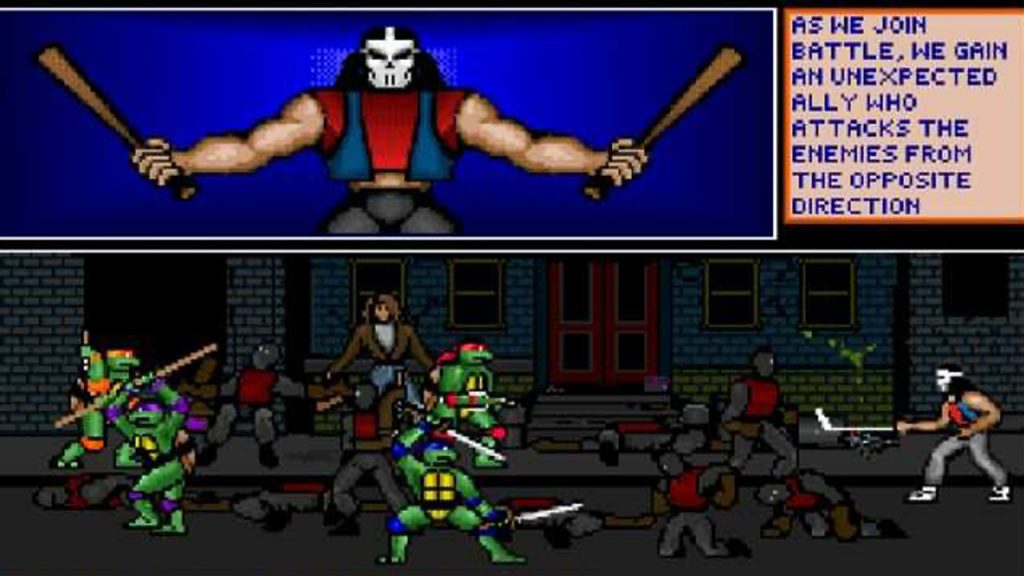
Manhattan Missions was released in 1991 only on DOS, so few people know about it. Moreover, she suddenly relies on the same animated series, and on the original comics about turtles, and on the first film in 1990 at the same time. And thats good – where else in the games will you see the original image of Shredder and the gloomy tone of the original comic book? Even Casey Jones in the plot is finally not in tenth roles.
In general, the game loosely retells the first issue of the original comic from Mirage Studios. The turtles just got out of the sewer and immediately heard the scream of a woman. Rushing to the rescue, they met the Foot Clan fighters who surrounded April. The heroes entered the battle, during which Casey suddenly joined them – so he became their faithful ally. Back in the sewers, the turtles listened to Splinters story about their origins and Shredder. Later, they saw a report on TV, where they showed a video sent by Shredder – the villain promised to capture New York in 48 hours. The heroes decided to stop him. Of course they win.
Manhattan Missions, a 2D action-platformer, is very different from all other turtle games in terms of gameplay inspired by the classic Prince of Persia. In these “Turtles”, as well as in the “Prince”, the division into “research” and “combat” modes is also clearly traced. The battles here are slow and tactical, reminiscent not only of The Prince, but also of Jordan Mechner's other game, Karateka.
You can complete Manhattan Missions under the guise of any of the turtles, and here the choice affects the gameplay much more than in the games listed. Its not just a set of attacks – the turtles have individual characteristics: strength, speed and endurance. The same 48 hours are given for the passage (not real time, of course), and between missions you need to make a difficult decision – to rest and restore health or immediately go further. Playing Manhattan Missions today is weird due to the slow pace, but smooth Prince of Persia-style animation and good pixel art make it passable even 30 years after release.
Teenage Mutant Ninja Turtles II: Back from the Sewers (1991)

The original, monochrome Game Boy had its own trilogy of Teenage Mutant Ninja Turtles. Allowing for platform limitations, each part is worthy, but it is necessary to advise them with great care – this is quite a decrepit retro. If you already choose the best of them, then it’s better to stop at the second part, because the first is the simplest, and in the third you can only play as Michelangelo.
The game is almost unencumbered by the plot – the turtles again save the kidnapped April, fight with Shredder and his henchmen, and at the end they encounter Krang. Back from the Sewers is a classic 2D platformer with a one-button combat system. However, due to the difference in range and attack speed, the passages for each of the turtles are still different. There are also two “skateboard” levels in the game, in which the gameplay changes slightly and it becomes possible to move deeper into the screen – like in the turtle beatem up games on the NES and SNES.
But the main reason to launch the game today is not the gameplay at all.Its worth a try because of the excellent pixel art and crystal eight-bit music. Back from the Sewers is one of the most technologically advanced games on the Game Boy.
Teenage Mutant Ninja Turtles: The Hyperstone Heist (1992)
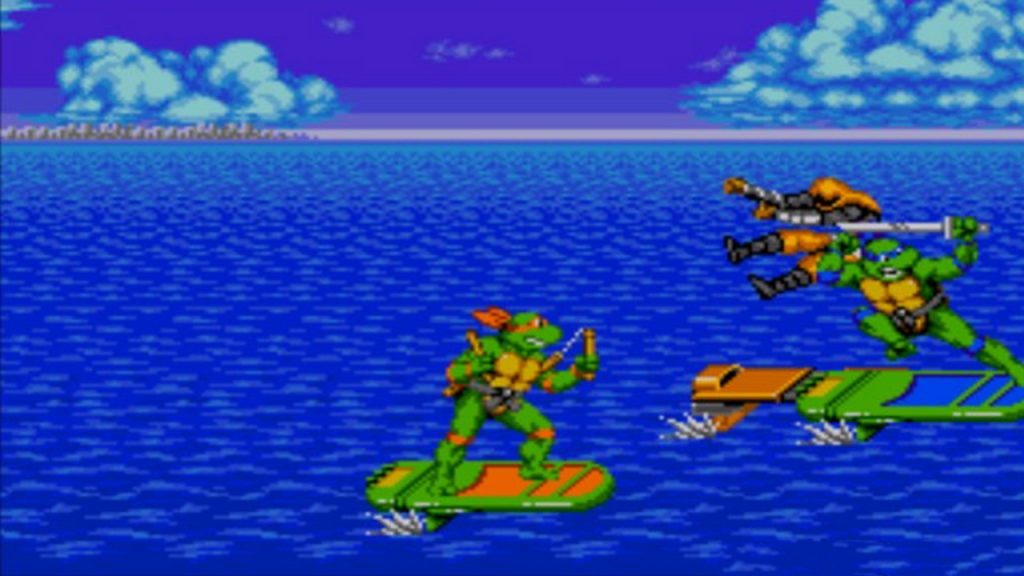
This is a wild remix of Turtles in Time, created exclusively for Mega Drive. The beginning of the game repeats the beginning of the story of Teenage Mutant Ninja Turtles IV, but the plot turns in the other direction. The Statue of Liberty disappears as if by itself, and then we see Shredder, who adds a reduced statue to his collection and promises to show the full power of the hyperstone, an artifact from Dimension X.
The gameplay of The Hyperstone Heist is an exact copy of Turtles in Time, but noticeably accelerated and with more daring opponents. The only thing missing is the ability to throw enemies around the level. The levels themselves have become longer, but their number has been reduced to five. At the same time, the locations are a mixture of levels from Turtles in Time, the very first turtle arcade game, and new ideas.
All in all, despite being based on Turtles in Time, The Hyperstone Heist feels like it's a brand new game – many consider it to be one of the best beatem ups on the Mega Drive. And one of the most difficult – the dynamics here are such that sometimes even Contra: Hard Corps will envy her.
TMNT (2007)
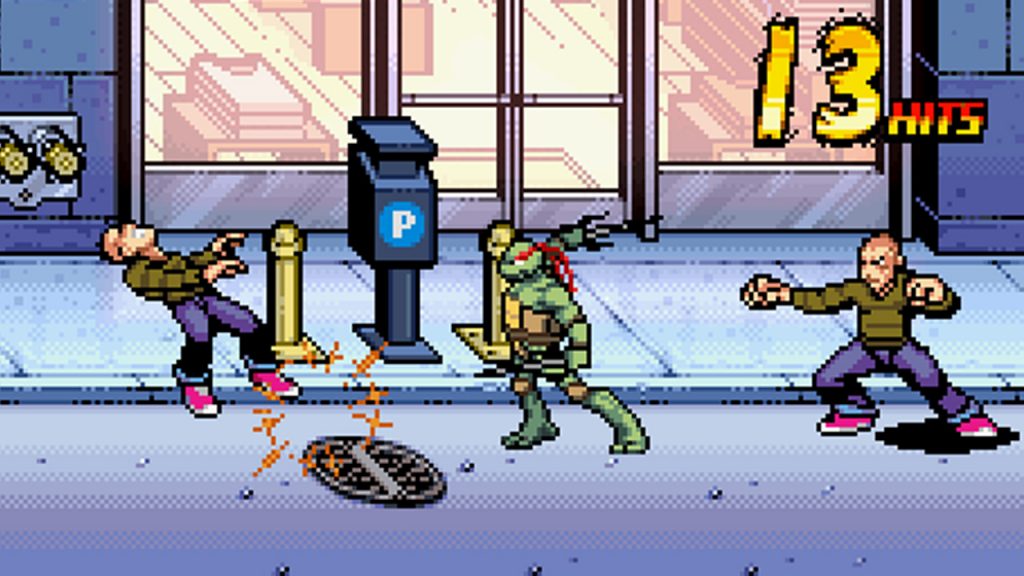
In 1996, the animated series Teenage Mutant Ninja Turtles ended, and the turtles disappeared from the screens right up to the restart in 2003 (not counting one season of the not-so-successful game series that started in 1997). At the same time, games about turtles returned, but they entered the new millennium sadly. Based on the new animated series, Konami annually riveted games “for children” – with a one-button combat system, endless self-replays and a complete lack of impact in battles.
The industry at that time saw a lot of such games based on cartoons. Somehow, only the Game Boy Advance and Nintendo DS versions could be tolerated – weak beatem ups of the same type, they at least caused bouts of nostalgia for the 1990s. But thats nothing, because in the middle of the 2000s, the studio relied on cheap J2ME handicrafts for phones.
In 2007, the era of Konamis Turtles ended – Ubisoft got the rights to them. Based on the TMNT 3D cartoon released in the same year, she released a game – with the combat simplified to the limit from Prince of Persia: Warrior Within and parkour from the same. Thank you for the last, but acrobatics alone did not save the game – in terms of battles, even the game of 2003 surpassed it.
But the GBA version created as an add-on turned out to be an order of magnitude more interesting! It was a very cheerful, detailed pixel art beatem up in the style of River City Ransom. Turtles here not only give out spectacular combos, but also know how to pick up weapons that have fallen from enemies, as well as throw elements of the environment. TMNT was developed by Ubisoft Montreal, which later released an excellent game based on Scott Pilgrim – with exactly the same gameplay.
But there is also something repulsive in the game. It is based on the 2007 animated cartoon and follows its plot. The story is served between missions, with gruesome cartoon footage in horribly reduced resolution. It looks incredibly cheap and tasteless.
After TMNT in 2007, everything went back to mobile phones.There was also a twisted misunderstanding for Xbox Live Arcade based on the 2014 movie, and several attempts to remake 1990s classics in 3D, all equally ugly and primitive. The bright spot was only the appearance of the turtles as guest fighters in the fighting game Injustice 2 – this can be inferred from how Nickelodeon, which owns the Teenage Mutant Ninja Turtles, treated video games based on them.
But “Teenage Mutant Ninja Turtles: Shredders Revenge” is already at the announcement stage – and this is a sure bid for success. The game is based on the classic animated series, like almost all the best games about turtles – this trend can be seen in our list. The Tribute Games studio is responsible for the development, at the origins of which were the people who made TMNT from our top. Dotemu will publish new “Turtles” – last year the studio released Streets of Rage 4, and in 2017 returned the Wonder Boy series. All the ingredients for a good game are in place.


